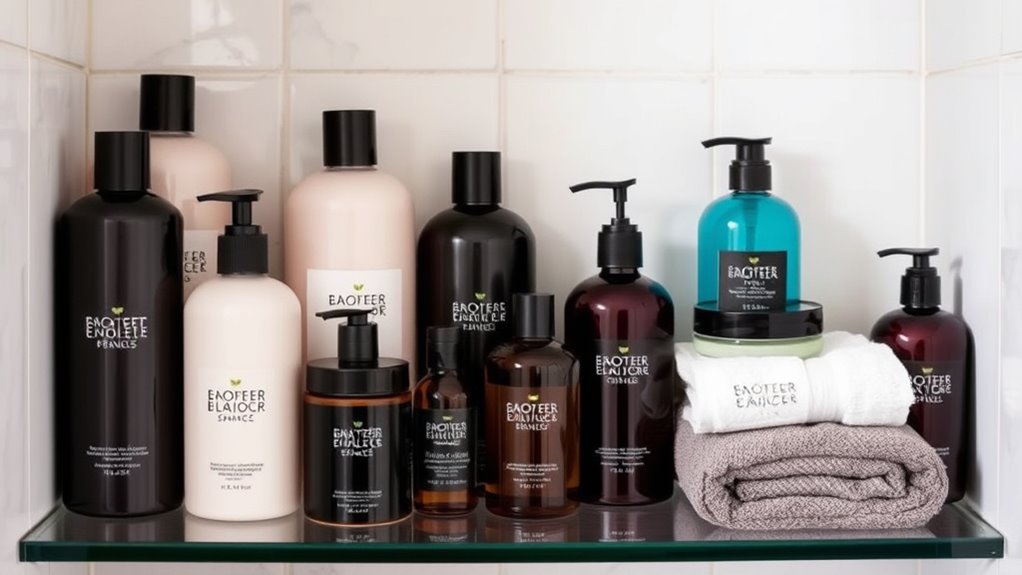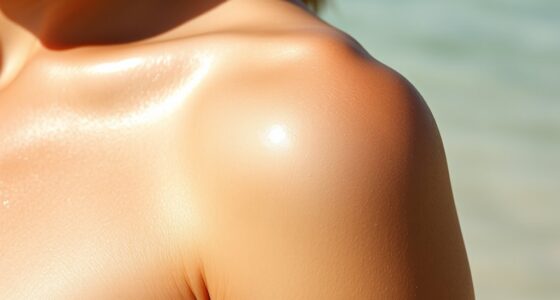To maximize your body care products during a shower, start with warm, wet skin to open pores and improve absorption. Use a gentle body wash, then exfoliate lightly to remove dead skin cells. Rinse thoroughly and pat dry, leaving your skin slightly damp. Apply serums, oils, and moisturizers in order from lightest to heaviest to boost effectiveness. Finish with sunscreen or protective products to shield your skin. Keep exploring to refine your routine further.
Key Takeaways
- Wet your body thoroughly before applying any products to ensure optimal absorption and skin hydration.
- Start cleansing with a gentle body wash or soap, focusing on sweat-prone areas, then rinse completely.
- Exfoliate after cleansing to remove dead skin cells, enhancing product penetration and skin smoothness.
- Apply lightweight serums or oils first, followed by thicker moisturizers, layering from thin to thick for effectiveness.
- Finish with sunscreen or protective products last to shield skin from environmental damage and maximize product benefits.
Start With a Warm, Wet Body
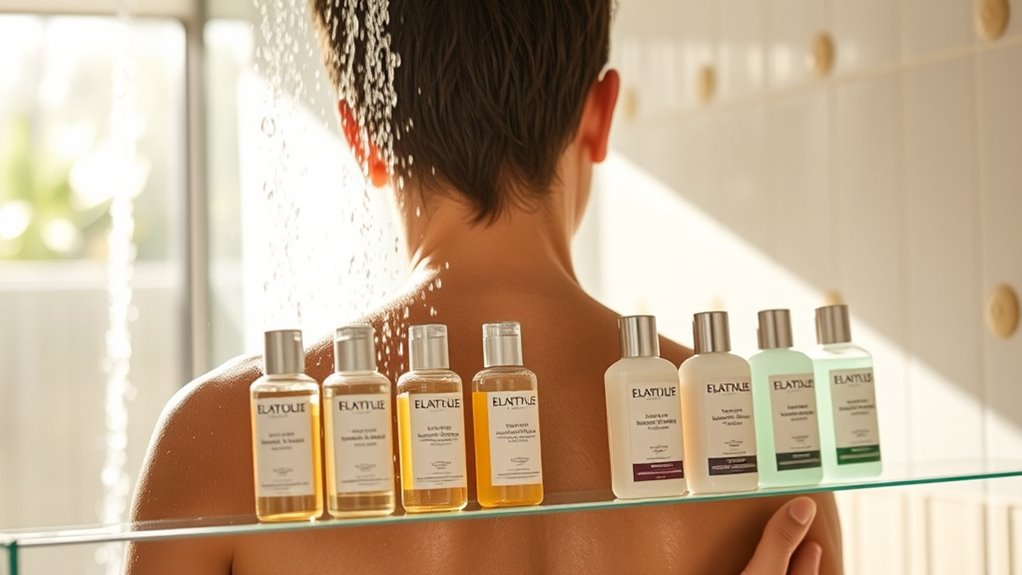
To begin your shower effectively, make sure your body is warm and wet before applying any soap or shampoo. This helps open your pores, allowing cleansing products to work more efficiently. Turn on the water and adjust it to a comfortable temperature, ensuring it’s warm enough to relax your muscles and soften your skin. Step into the shower and let the water cascade over you, thoroughly wetting your entire body. This initial wetting prepares your skin for cleansing, making it easier for soap and shampoo to lather and remove dirt, oil, and sweat. Properly wetting your skin can also help prevent soap from drying out your skin, maintaining skin hydration during your shower. Incorporating the right water temperature can also enhance your overall shower experience, making it more relaxing and effective. Additionally, properly wetting your skin can assist in better product absorption, ensuring your skincare products work more efficiently. Properly preparing your skin also supports skin health, leading to a more radiant and smooth complexion.
Cleanse With a Gentle Body Wash or Soap

After your body is thoroughly wet, apply a gentle body wash or soap. Use your hands or a soft loofah to distribute the product evenly across your skin. Focus on areas that tend to get sweaty or dirty, like your underarms, groin, and feet. Choose a formula that’s free of harsh chemicals and fragrances to avoid irritation. Let the wash sit for a moment to loosen dirt and oils before rinsing thoroughly. This step cleanses your skin without stripping away natural oils, helping to maintain your skin’s moisture barrier. Incorporating a moisturizing formula can further protect your skin during cleansing. Proper cleansing helps preserve your skin’s natural defenses against environmental factors like UV rays, which can cause skin damage over time. Additionally, using gentle cleansing products can minimize skin irritation and support your skin’s health. Engaging in mindful cleansing can also enhance your body care routine by promoting relaxation and awareness during your self-care. When selecting products, consider those that are designed with sensitive skin in mind to further reduce the risk of irritation. Keep the process simple and mindful to set a solid foundation for your body care routine.
Exfoliate to Remove Dead Skin Cells
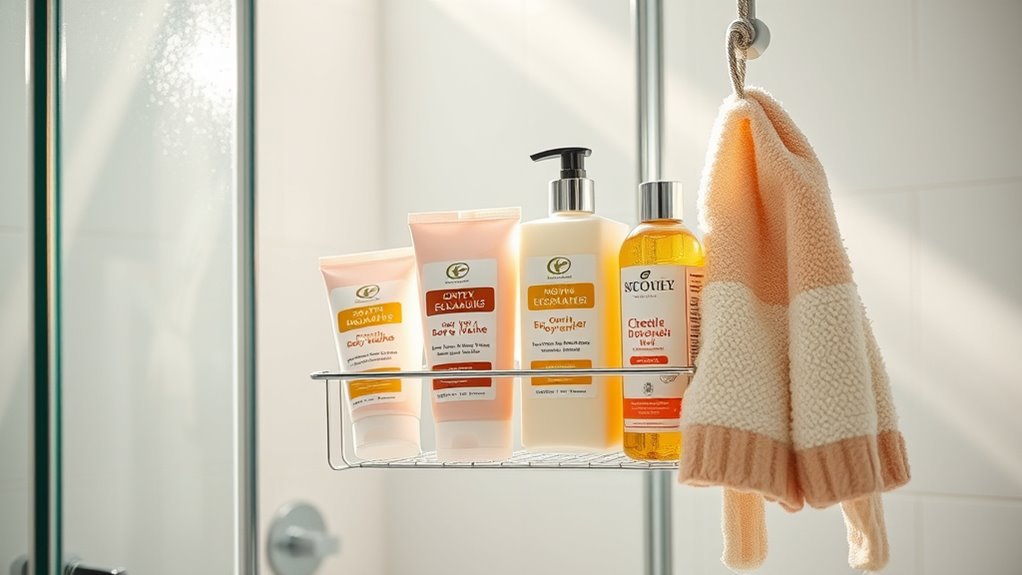
Exfoliating helps remove dead skin cells and reveals smoother skin. Use gentle techniques like a soft scrub or a mild brush, and avoid overdoing it. The best results come when you exfoliate after cleansing and not too often—usually once or twice a week. Incorporating exfoliation methods into your routine can enhance your relaxation experience during skincare. Regular exfoliation also supports skin cell renewal, leading to healthier and more radiant skin over time. Additionally, choosing appropriate exfoliation techniques can prevent irritation and maintain your skin’s natural barrier.
Gentle Exfoliation Techniques
Gentle exfoliation techniques help you remove dead skin cells without causing irritation or damage. Using mild scrubs or soft tools guarantees your skin stays smooth and healthy. Opt for gentle circular motions and avoid over-exfoliating, which can lead to irritation. Choose products suited for your skin type and avoid harsh ingredients. To help you decide, here’s a quick comparison:
| Method | Suitable For |
|---|---|
| Sugar or salt scrubs | Normal to oily skin |
| Konjac sponge | Sensitive or dry skin |
| Chemical exfoliants | Acne-prone or dull skin |
Stick to exfoliating 1-2 times a week, and always follow with moisturizer. This keeps your skin refreshed without compromising its barrier. Incorporating gentle exfoliation techniques supported by AI-driven analysis can further optimize your skincare routine.
Timing for Best Results
Timing your exfoliation sessions properly guarantees you get the most benefits without risking irritation. Exfoliating 2 to 3 times a week is ideal for most skin types, but avoid overdoing it, as too much can strip your skin’s natural oils and cause redness. The best time to exfoliate is after your shower has softened your skin, making dead cells easier to remove. Doing it too early or too late may reduce effectiveness or cause irritation. Always listen to your skin; if you notice redness or dryness, cut back on exfoliation. For maximum results, exfoliate before applying body treatments like moisturizers or serums, so your skin can absorb these products better. Proper timing ensures smoother, healthier skin without unnecessary discomfort. Incorporating color accuracy knowledge can also inspire you to create a relaxing skincare routine that complements your beach visits and keeps your skin healthy.
Rinse and Pat Dry Before Applying Treatments

Before applying any treatments after your shower, make sure to rinse your skin thoroughly and pat it dry. Removing excess water ensures your skin isn’t slippery, helping your products absorb better. Use a clean towel to gently pat your skin, avoiding vigorous rubbing that can cause irritation. Wait until your skin is mostly dry, but not completely air-dried; slightly damp skin can enhance absorption of oils and serums. Pay special attention to areas where you plan to apply treatments, ensuring they’re free of water droplets. This step helps prevent dilution of your products and reduces the risk of clogged pores. Additionally, choosing an appropriate skin preparation method can optimize the efficacy of your body care routine. Incorporating protective styling benefits into your routine can also help maintain the health of your hair and skin. Taking the time to rinse and pat dry creates a clean, ideal surface, allowing your body care products to work more effectively.
Apply Serums, Oils, and Moisturizers in the Correct Order
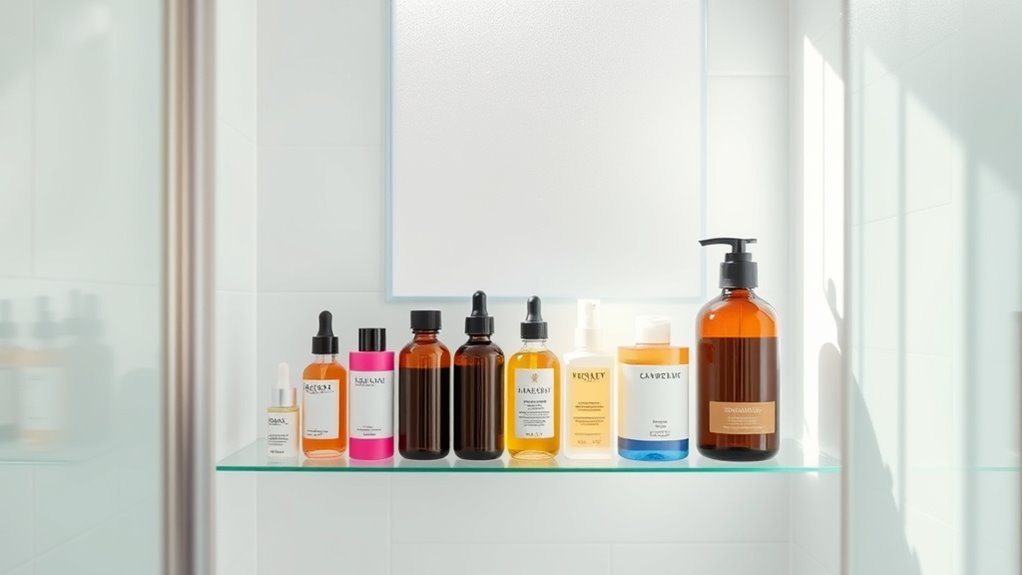
After ensuring your skin is properly rinsed and patted dry, it’s time to apply your serums, oils, and moisturizers in the correct order. Start with the thinnest, most lightweight formulas, like serums, to allow absorption. Next, apply oils, which lock in moisture and nutrients. Finish with thicker moisturizers to seal everything in. To guide you, consider this order:
| Step | Product Type | Purpose |
|---|---|---|
| First | Serums | Absorbs quickly, targets specific concerns |
| Second | Oils | Nourishes and locks in hydration |
| Third | Moisturizers | Seals in all previous layers |
Following this sequence ensures maximum effectiveness and hydration for your skin. Proper layering can also help maximize product efficacy and prevent product pilling, enhancing your overall skincare routine. Additionally, incorporating a vertical storage solution can keep your products organized and easily accessible, supporting a more efficient application process. Regularly updating your routine with the right skincare layering order can further improve your skin’s health and appearance.
Finish With Sunscreen or Protective Products
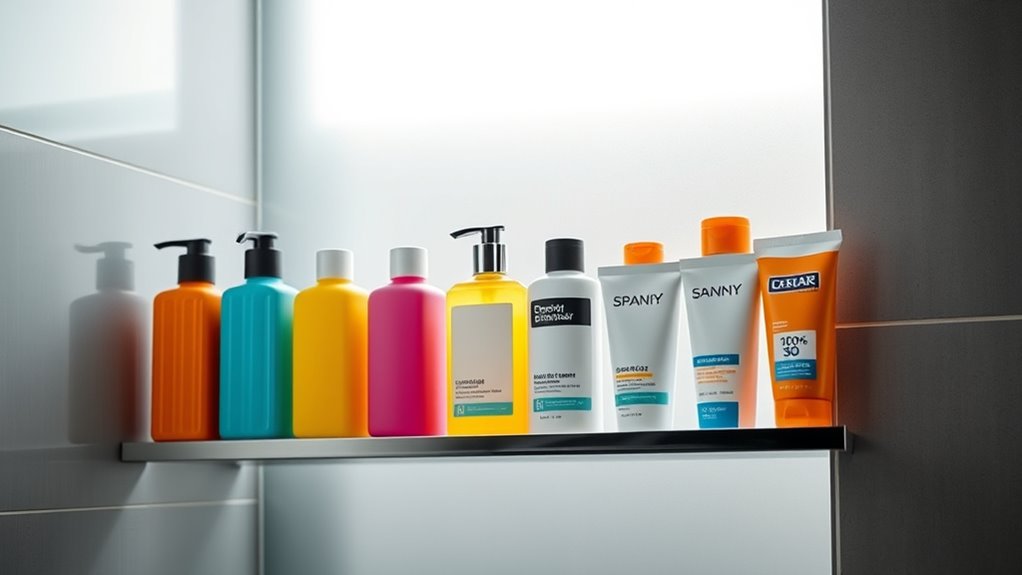
Once you’ve applied all your skincare products, finishing with sunscreen or protective products is essential to shield your skin from UV rays and environmental damage. Applying sunscreen last creates a barrier that locks in moisture and active ingredients while providing essential sun protection. Use a broad-spectrum SPF of at least 30, covering all exposed areas evenly. Don’t forget often-missed spots like your ears, neck, and the back of your hands. If you use additional protective products, such as after-sun creams or antioxidants, apply them after your sunscreen. Reapply sunscreen every two hours if you’re outdoors or sweating. Incorporating proper application techniques can maximize the effectiveness of your sunscreen and overall skincare routine. Ensuring your environment has good air quality, perhaps aided by a HEPA filter air purifier, can also contribute to healthier skin. Additionally, maintaining a hydrated skin barrier can further enhance your skin’s resilience against environmental stressors. Finishing with sunscreen ensures your skin stays protected throughout the day, preventing premature aging, sun spots, and potential skin cancers. Proper application maximizes the benefits of your entire skincare routine. Low light office plants can be a great addition to your workspace to support overall well-being and air quality.
Frequently Asked Questions
Can I Skip Any Steps if I’M in a Hurry?
If you’re in a hurry, you can skip some steps, but keep in mind it might affect your results. You could skip shampooing if your hair isn’t dirty or skip certain body treatments like exfoliating. Focus on the essentials: washing your body thoroughly and applying your body care products afterward. Prioritize what matters most to you, but don’t skip the basics that keep your skin healthy and clean.
How Often Should I Exfoliate During My Shower Routine?
Think of exfoliating as sharpening your tools; it’s best done regularly but not overdone. You should exfoliate 2-3 times a week, depending on your skin type. If your skin feels sensitive or irritated, cut back. Remember, less is more—over-exfoliating can do more harm than good. Pay attention to how your skin responds, and adjust your routine accordingly. Keep your glow without going overboard.
Are There Products That Shouldn’T Be Layered Together?
You should be cautious about layering certain products, as some can cause irritation or reduce effectiveness. For example, avoid mixing acids like AHAs or BHAs with retinol or vitamin C, as they can destabilize each other. Also, don’t combine products with different pH levels or ingredients that might clog your pores. Always read labels and wait a few minutes between applying different products to minimize reactions and maximize benefits.
Should I Use Hot or Cold Water for Optimal Product Absorption?
Ah, the eternal debate: hot or cold water? You’ll want to skip the sauna effect and go for warm water instead. Hot water might feel like a spa, but it can strip your skin’s natural oils, reducing absorption. Cold water, on the other hand, tightens pores but isn’t great for product penetration. Aim for lukewarm water to maximize absorption and keep your skin happy.
When Is the Best Time to Apply Sunscreen During My Shower Routine?
You should apply sunscreen after your shower, once you’ve dried off and your skin is clean and cool. This guarantees your skin absorbs the product effectively and creates a protective barrier. Avoid applying sunscreen before getting out of the shower, as water and steam can weaken its effectiveness. By waiting until you’re dry, you give the sunscreen enough time to set, giving you better protection throughout the day.
Conclusion
Following the right shower order can boost your skin’s health and help your products work better. Did you know that applying moisturizer within three minutes of drying can lock in up to 50% more hydration? So, stay consistent with your routine, and you’ll see smoother, more radiant skin. Prioritize your body care order, and enjoy the benefits of a more effective and enjoyable shower experience every time.
